Im Tal von Twyfelfontein im Nordwesten von Namibia sind auf über 200 Felsplatten an die 2.500 Felszeichnungen eingeritzt. Die ältesten von ihnen reichen bis in die Steinzeit zurück.
Als Twyfelfontein (aus dem afrikaans wörtlich „Zweifelquelle“) werden eine Quelle und ein Tal im extrem trockenen Damara-Bergland im Nordwesten Namibias bezeichnet. Die weißen Farmer, die sich 1947 in der Region Kunene ansiedelten, befanden die Quelle als nicht zuverlässig und nannten sie daher Twyfelfontein. Diese Bezeichnung wurde später auf das gesamte Tal ausgeweitet.
Seit 1952 gilt das Tal etwa 90km westlich von Khorixas als Nationales Denkmal von Namibia und gehört zu unseren Top 10 Sehenswürdigkeiten von Namibia. 2007 wurde es von der UNESCO zum Weltkulturerbe ernannt.
Inhaltsverzeichnis
BILDER: Twyfelfontein
2500 Felsmalereien und -gravierungen in Twyfelfontein
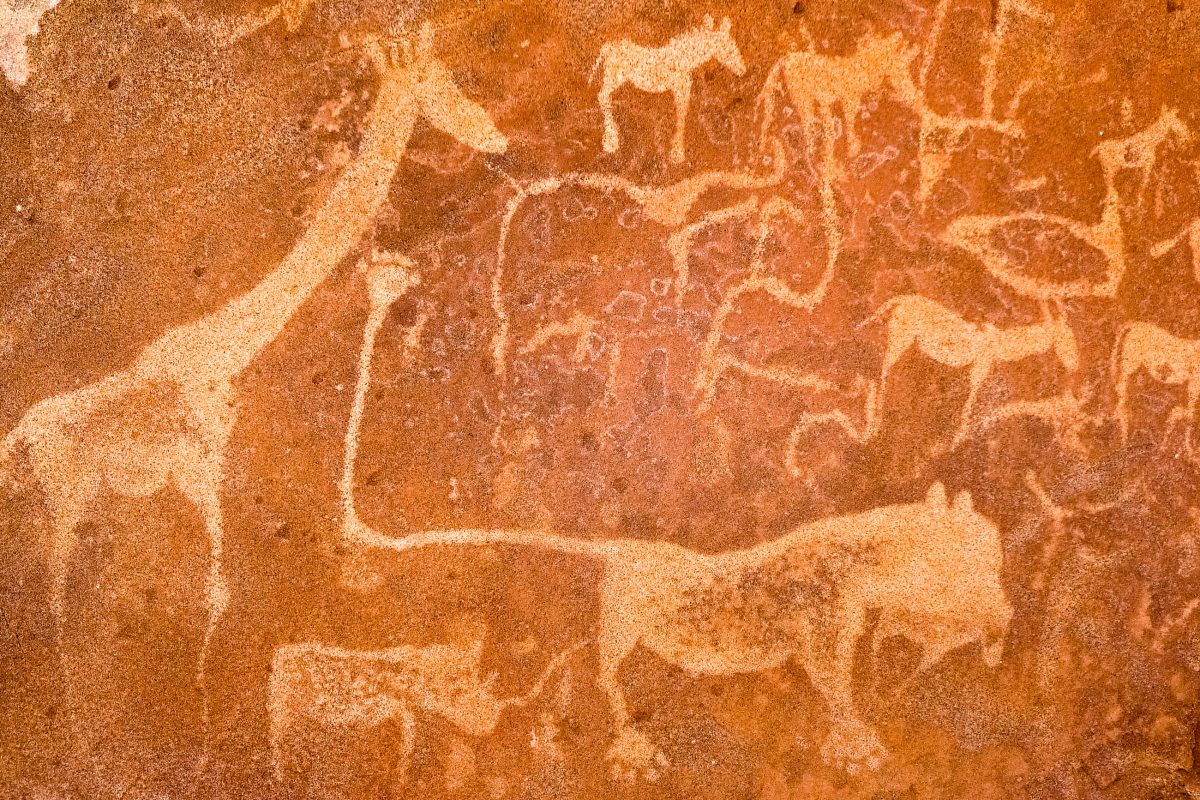
Die Attraktion von Twyfelfontein ist jedoch nicht seine zweifelhafte Quelle, sondern eine Unmenge an Felszeichnungen und -schnitzereien, die zu den ältesten Abbildungen auf dem gesamten afrikanischen Kontinent gehören.
Auf über 200 Felsplatten sind etwa 2.500 Abbildungen eingeritzt oder aufgemalt. Dabei sind überwiegend Jagdszenen dargestellt, in denen mit Pfeil und Bogen ausgerüstete Menschen auf Giraffen, Zebras, Antilopen, Nashörner und Löwen losgehen.Es gibt jedoch auch abstrakte Figuren und menschliche Fußabdrücke.
Die bekanntesten Felszeichnungen sind der „Große Elefant“, der „Tanzende Kudu“, ein ca. 20cm großes Fabelwesen, und die „Löwenplatte“, auf der ein Löwe mit mächtigen Pranken und abgeknicktem Schwanz zu sehen ist.
Etwas ungewöhnlich ist die Felszeichnung einer Robbe, da das Meer von Twyfelfontein über 100 Kilometer entfernt ist. Es wird angenommen, dass die Felsbilder keinen rituellen Sinn hatten, sondern vielmehr der Ausbildung von Kindern und Jägern dienten.
Entstehung der Felsbilder von Twyfelfontein
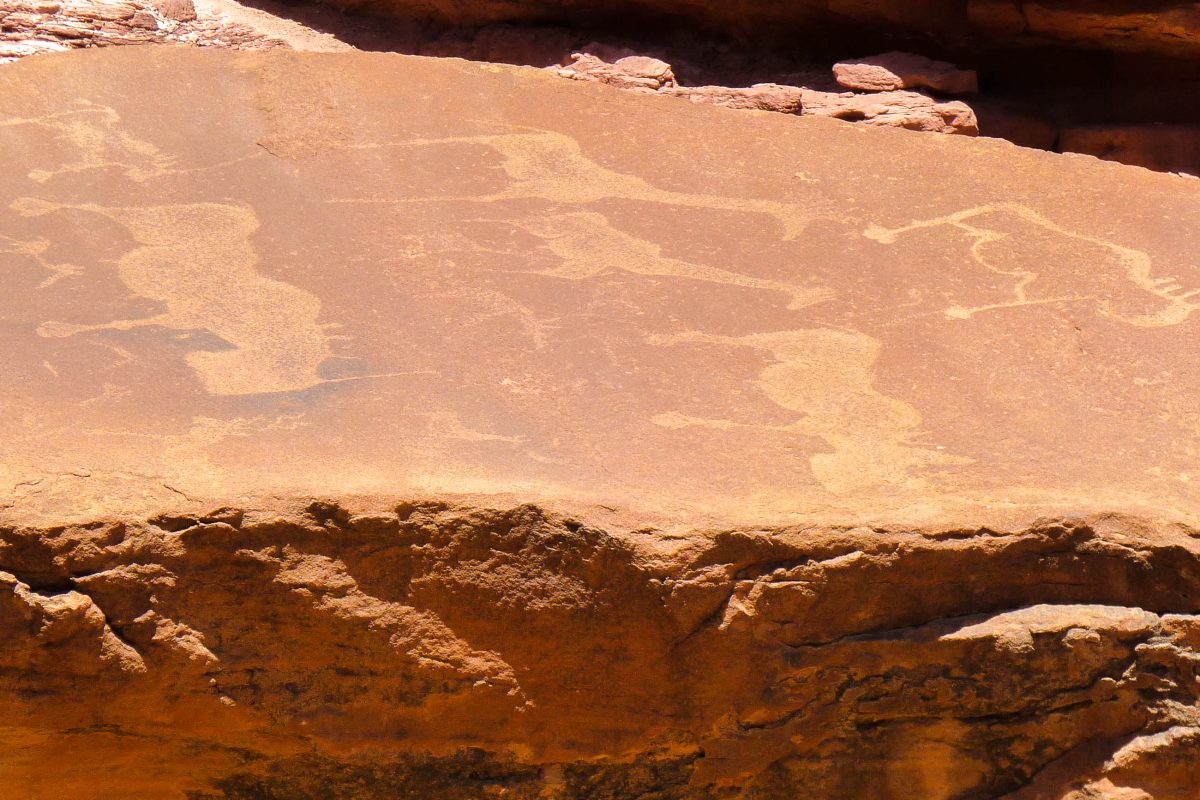
Die spektakulären Felsenbilder stammen von Kulturen aus der Mittel- und Jungsteinzeit und sind viele tausend Jahre alt. Erst 4.000 vor Christus konnte man die Felsbilder an Kulturen festmachen. Diese wurden zuerst der Wilton-Kultur und ab etwa 500 vor Christus den Khoikhoi zugeschrieben. Wer die Abbildungen „entdeckt“ bzw. dem europäischen Kulturkreis zugänglich gemacht hat, ist nicht geklärt.
Das Entstehungsalter der Felsbilder kann nur anhand der Oberflächenverwitterung des Gesteins geschätzt werden, da das Eisen im Sand mit der Zeit durch die Oxidation eine immer dunklere Rotfärbung annimmt. Es wird jedoch angenommen, dass die ältesten Graffiti über 10.000 Jahre alt sind und die jüngsten noch aus unserer Zeit stammen.
Hergestellt wurden die Ritzungen vermutlich mit Quarz-Werkzeugen, was ziemlich mühsam gewesen sein muss. Felsmalereien sind deutlich weniger zu finden, vielleicht haben sie aber auch einfach die Jahrtausende nicht so gut überdauert wie die eingeritzten Bilder.
Besichtigung der Felsbilder von Twyfelfontein
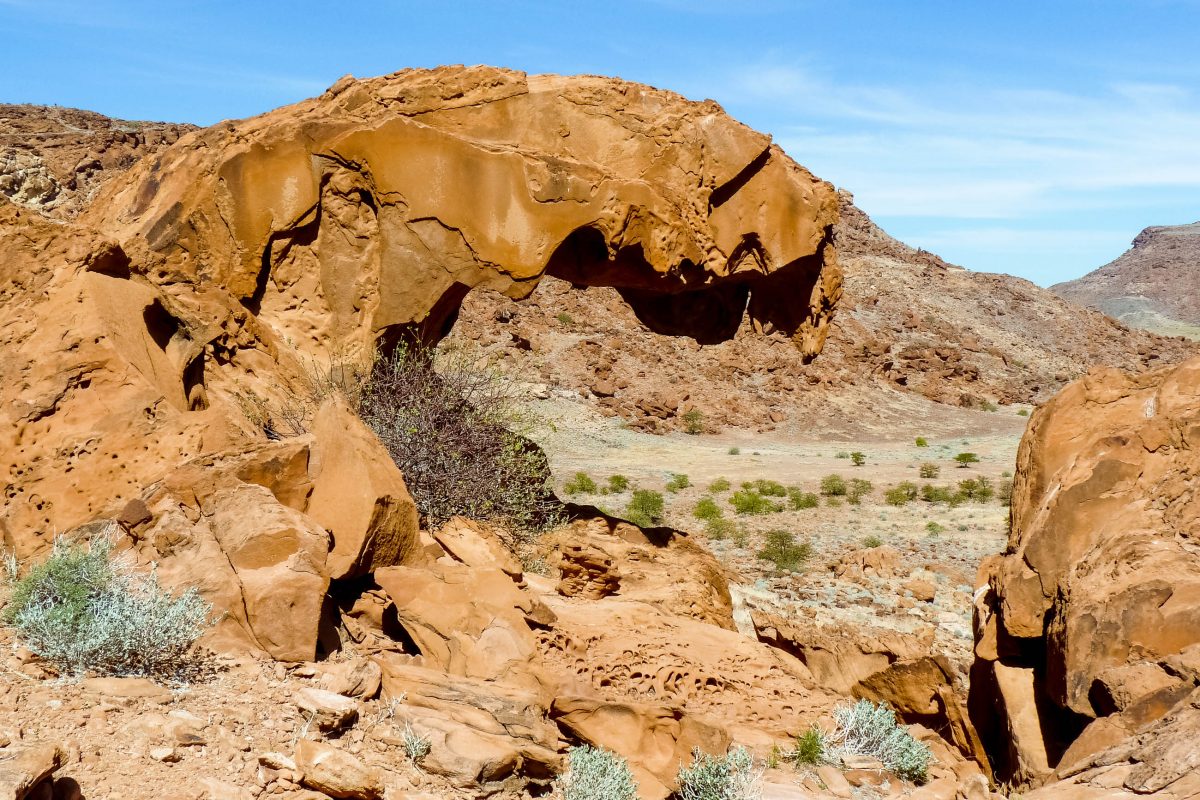
Die Felszeichnungen liegen gute zwei Autostunden von der Skelettküste entfernt. Zum Tal von Twyfelfontein biegt man von der C39 auf die D3254 ab. Vorbei an spektakulären Felsformationen führt eine gut befahrbare Piste bis zu einem Parkplatz.
Im Besucherzentrum bezahlt man eine kleine Gebühr und kann dann in Begleitung eines Führers das Gelände besichtigen. Eine Erkundung auf eigene Faust ist nicht möglich.
Es gibt eine kurze und eine lange Route durch das Gelände. Ein ausgeschilderter Rundwanderweg führt zu den acht schönsten Steinplatten, für den man etwa 2 Stunden Zeit einplanen sollte. Dieser führt auch am steinernen „Löwenmaul“ vorbei.
Der Weg ist teilweise steil und schwierig zu begehen, gutes Schuhwerk ist daher sehr empfehlenswert. In der Hitze Namibias ist auch an ausreichend Wasser und Sonnenschutz zu denken.
Tipp: Die Führer nehmen überwiegend die kurze Route. Wer alle Felsbilder und auch die berühmte Felsformation – das Löwenmaul – sehen will, sollte auf die lange Route bestehen. Die Führer sprechen hauptsächlich einfaches Englisch.
Strenger Schutz der Felsbilder

Viele der gravierten und bemalten Felsen wurden bereits entwendet, wodurch Twyfelfontein mittlerweile streng geschützt ist. Es ist wohl überflüssig zu erwähnen, dass das Mitnehmen von Steinen aus dem historisch wertvollen Tal nicht gestattet ist. Auch die sonstige Behelligung der Gravuren ist streng verboten.
Tipp: Wer die Felsbilder in aller Ruhe und große Touristenmassen besichtigen möchte, sollte eine Übernachtung im nahegelegenen Aba Huab einlegen. Von dort kann man in der Früh zu den Felsbilder aufbrechen und vermeidet so die Busgruppen.
Sehenswürdigkeiten in der Nähe von Twyfelfontein
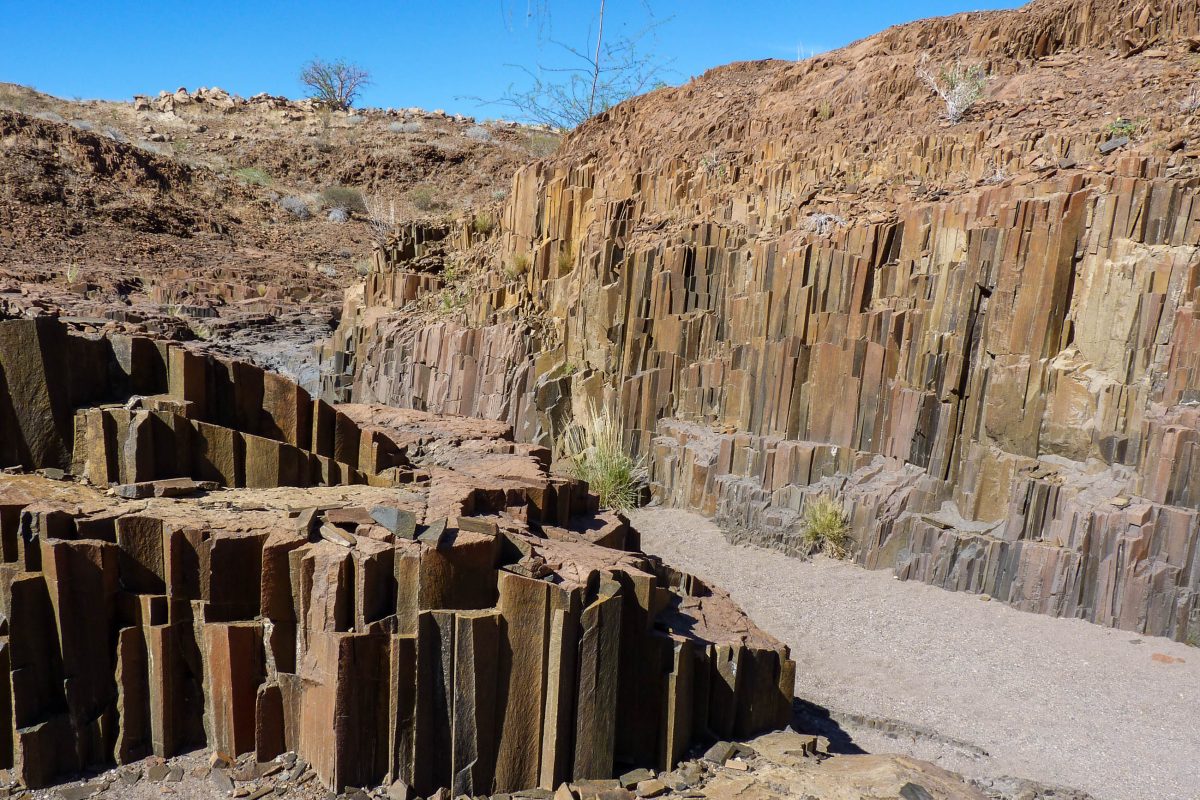
Auf dem Weg von Twyfelfontein nach Khorixas lohnt es sich, noch kurz einigen anderen Naturphänomenen in dieser Gegend einen Besuch abzustatten. Sie sind ebenfalls Zeugen aus längst vergangenen Zeiten, die zum Teil jedoch nicht von Menschen geschaffen wurden.
Verbrannter Berg
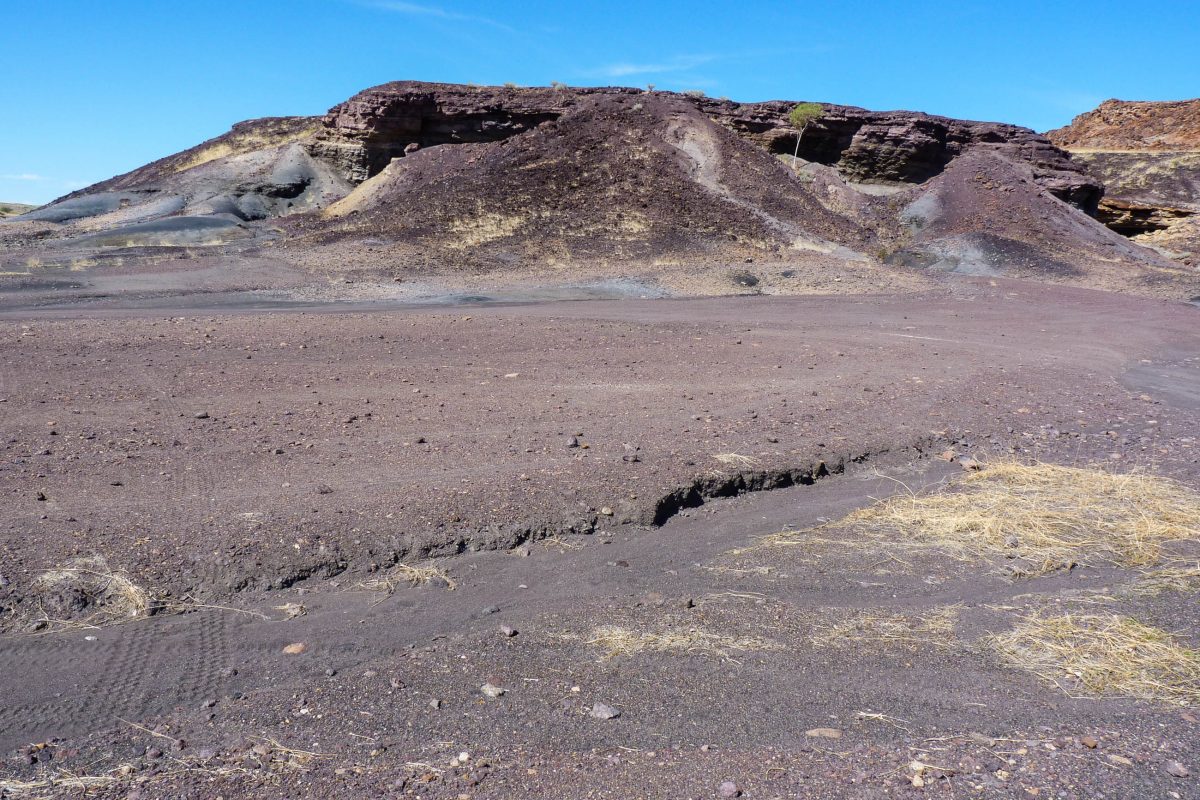
Mit dem verbrannten Berg liegt rund 10km oder 8 Autominuten südlich vom Tal von Twyfelfontein ein weiteres – wenn auch weniger spektakuläres – Nationaldenkmal. Der verbrannte Berg, in der Landessprache der „verbrande Berg“, entstand vor rund 80 Millionen Jahren aus einem Lavastrom, der langsam abkühlte.
Es gab hier zwar nie ein Feuer, dennoch sieht der verbrannte Berg tatsächlich angekokelt aus. Aufgrund seiner grau-schwarzen Farbe ist er inmitten des beige-sandigen Schiefergesteins der Umgebung auch so auffällig, dass er am 15. September 1956 sogar zum nationalen Denkmal von Namibia ernannt wurde.
Farbenspiel bei Sonnenuntergang
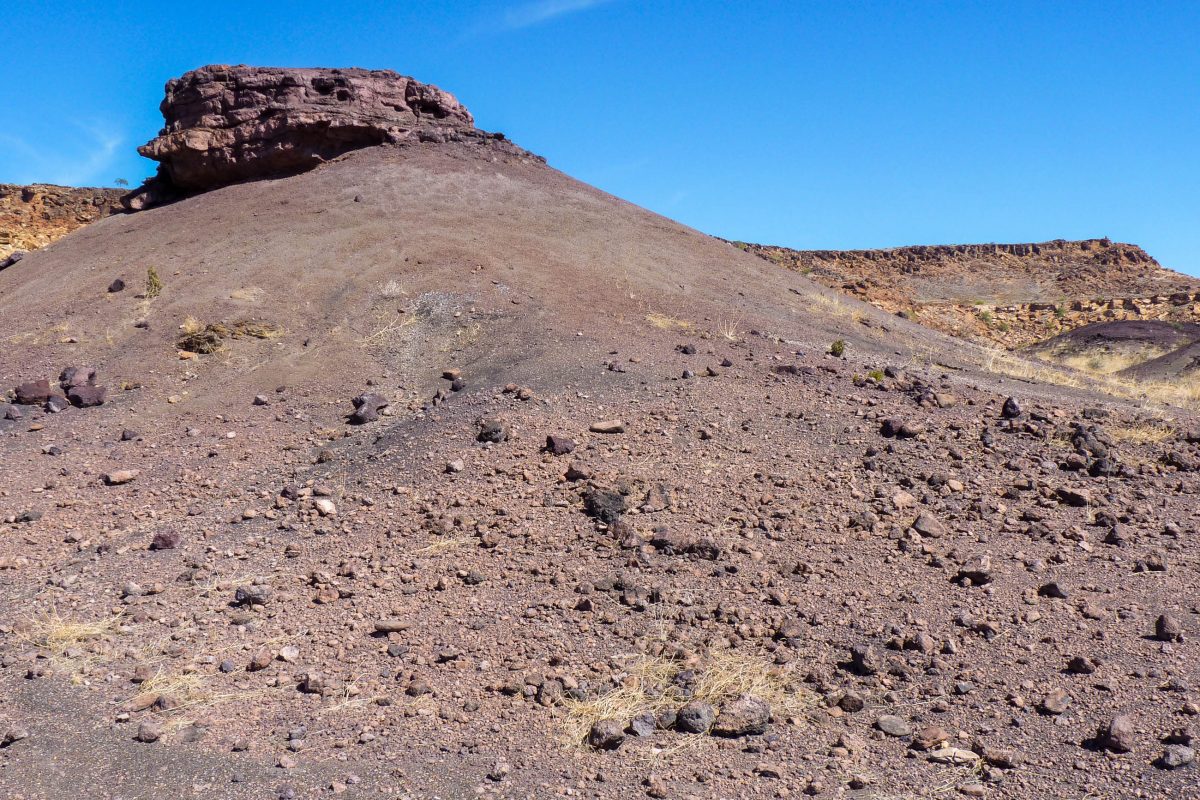
Kurz vor Sonnenuntergang ist der verbrannte Berg am interessantesten anzusehen. Dann entlockt die Abenddämmerung der uralten Lava sehenswerte, rot-violette Farbenspiele, mit denen sich der dunkle, rund 200 Meter hohe Hügel noch intensiver von der Umgebung abhebt. Tagsüber gleicht er eher einem unspektakulären Geröllhaufen, dessen Besichtigung unter der sengenden Sonne sich nur auszahlt, wenn man gerade daran vorbei fährt.
Der verbrannte Berg sollte übrigens nicht mit dem Brandberg gut 100km weiter südlich verwechselt werden, der übrigens den Titel des höchsten Berges Namibias trägt!
Orgelpfeifen
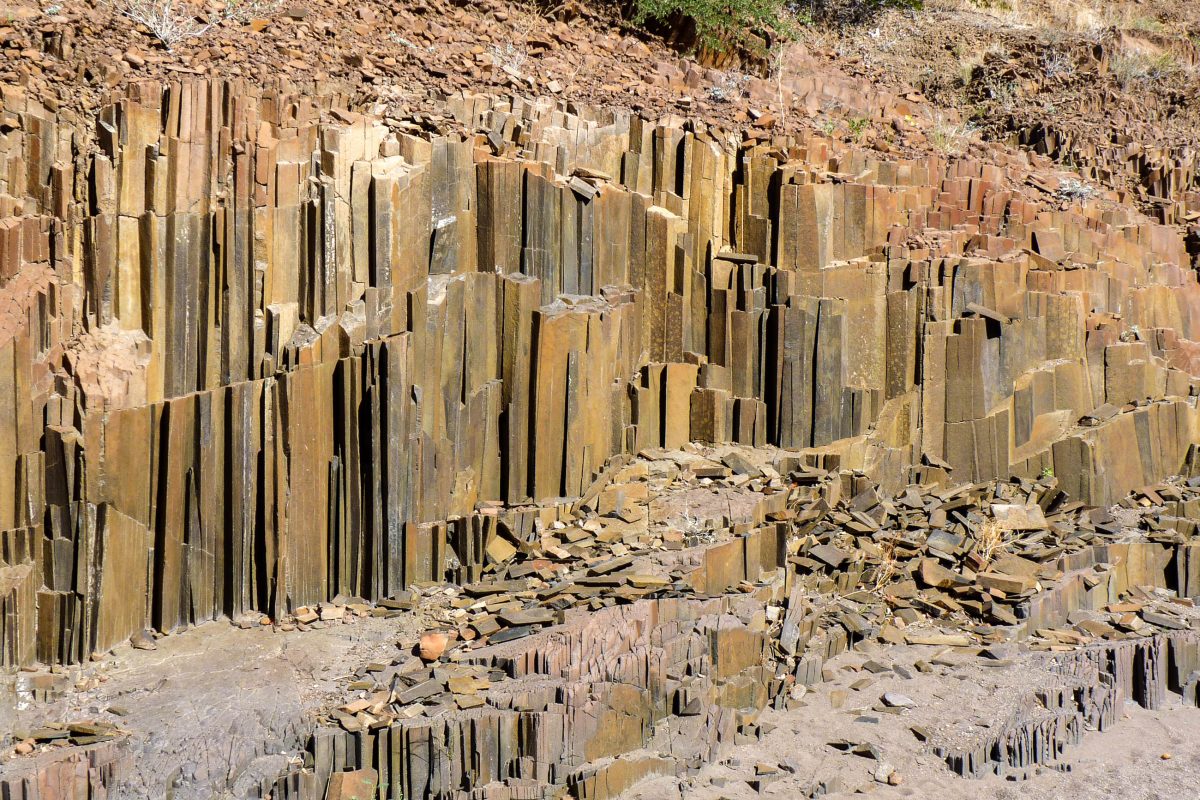
Noch etwas weiter südlich liegen Namibias „Orgelpfeifen“. Die faszinierenden Gesteinsformationen entstanden vor rund 150 Millionen Jahren, als flüssige Lava in das vorhandene Schiefergestein eindrang. Innerhalb des Basalts kühlte die Lava sehr langsam und gleichmäßig ab und formte die künstlich anmutenden Felsnadeln, deren senkrechte Flächen an Bauklötze erinnern.
Als das weichere Gestein um die erstarrte Lava durch Witterung und Erosion im Lauf der Jahrmillionen abgetragen wurde, wurde ein regelrechter Wald aus Orgelpfeifen sichtbar. Die größten von ihnen erreichen eine Höhe von bis zu 2 Metern, auch wenn sie gekonnte Weitwinkel-Aufnahmen in diversen Prospekten höher wirken lassen.
Wanderweg im ausgetrockneten Flussbett
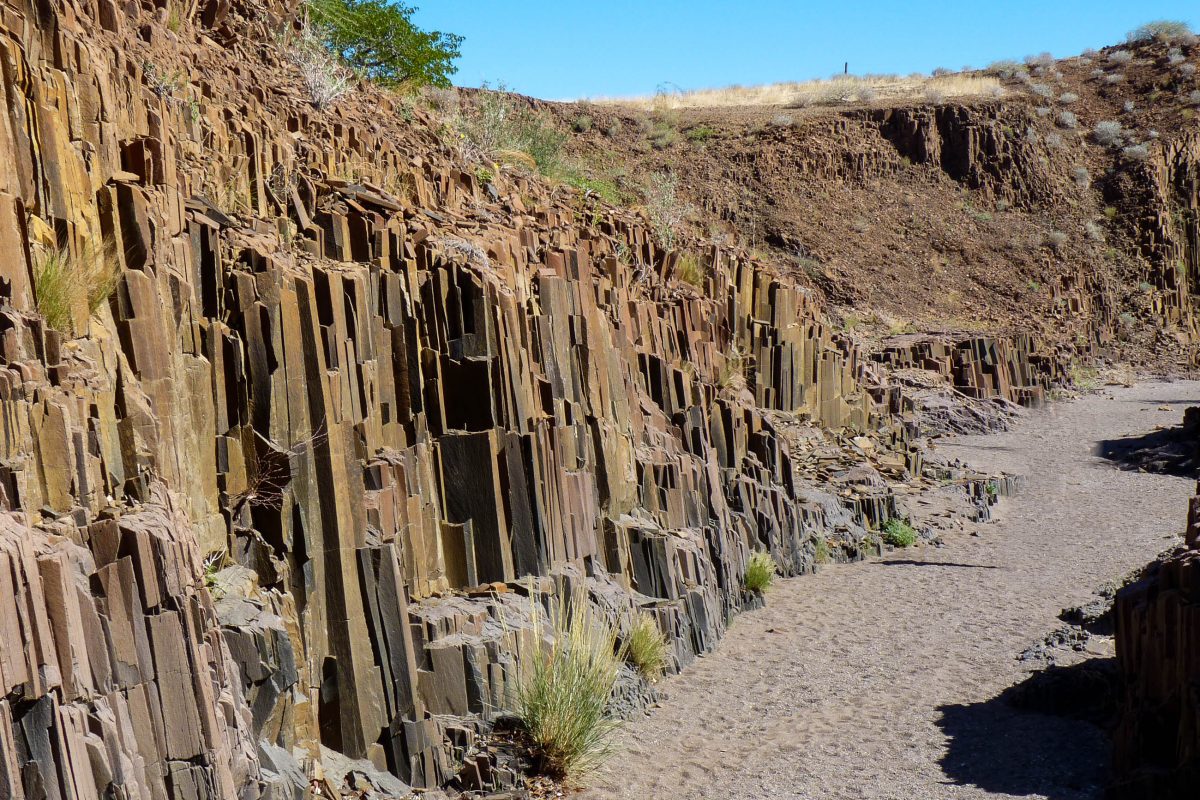
Einst floss zwischen den Orgelpfeifen im Damaraland ein Fluss, der wohl auch zur Freilegung der eckigen Basaltsäulen beigetragen hatte. Dieser ist mittlerweile ausgetrocknet und hinterließ sein Bachbett freundlicherweise als bequemen Spazierweg, der sich auf einer Länge von rund 100 Metern durch die faszinierend geformten Felswände schlängelt.
Eine ähnliche Laune der Natur ist übrigens auch in Nordirland, nahezu am anderen Ende der Welt, beim Giant’s Causeway zu besichtigen.
Versteinerter Wald
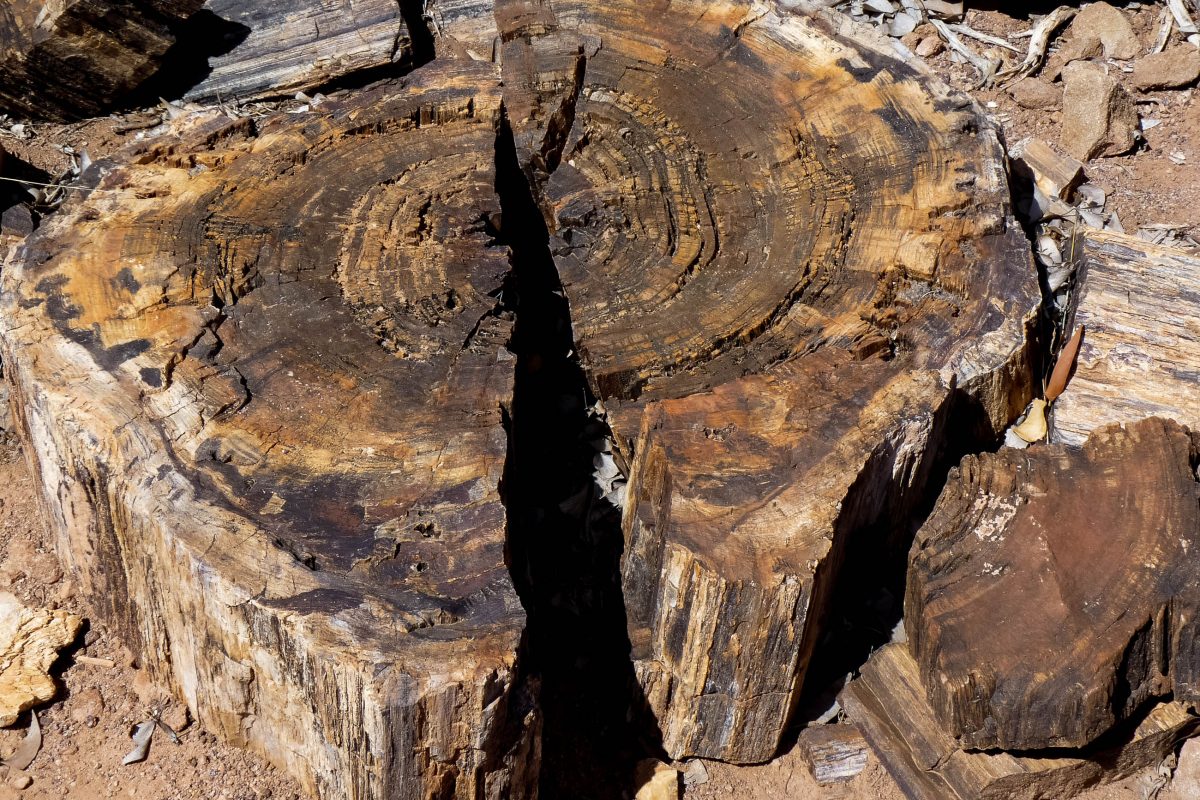
Der berühmte „Versteinerte Wald“ befindet sich hinter einem Zaun direkt an der C39 etwa 30 Kilometer westlich von Khorixas. Die gigantischen Baumriesen, die zwischen 240 und 300 Millionen Jahren alt sind, zählen ebenfalls zu unseren Top 10 Sehenswürdigkeiten von Namibia. Die Bäume sehen auch nach dieser langen Zeit immer noch aus, als wären sie aus Holz, berührt man sie jedoch, sind sie hart und kalt wie Stein. Die Bäume sind uralte Zeitzeugen der Epoche, als auf unserer Erde die Kohle entstanden ist, also unermesslich lange bevor die Menschen unseren Planeten bevölkerten.
Der „offizielle“ versteinerte Wald
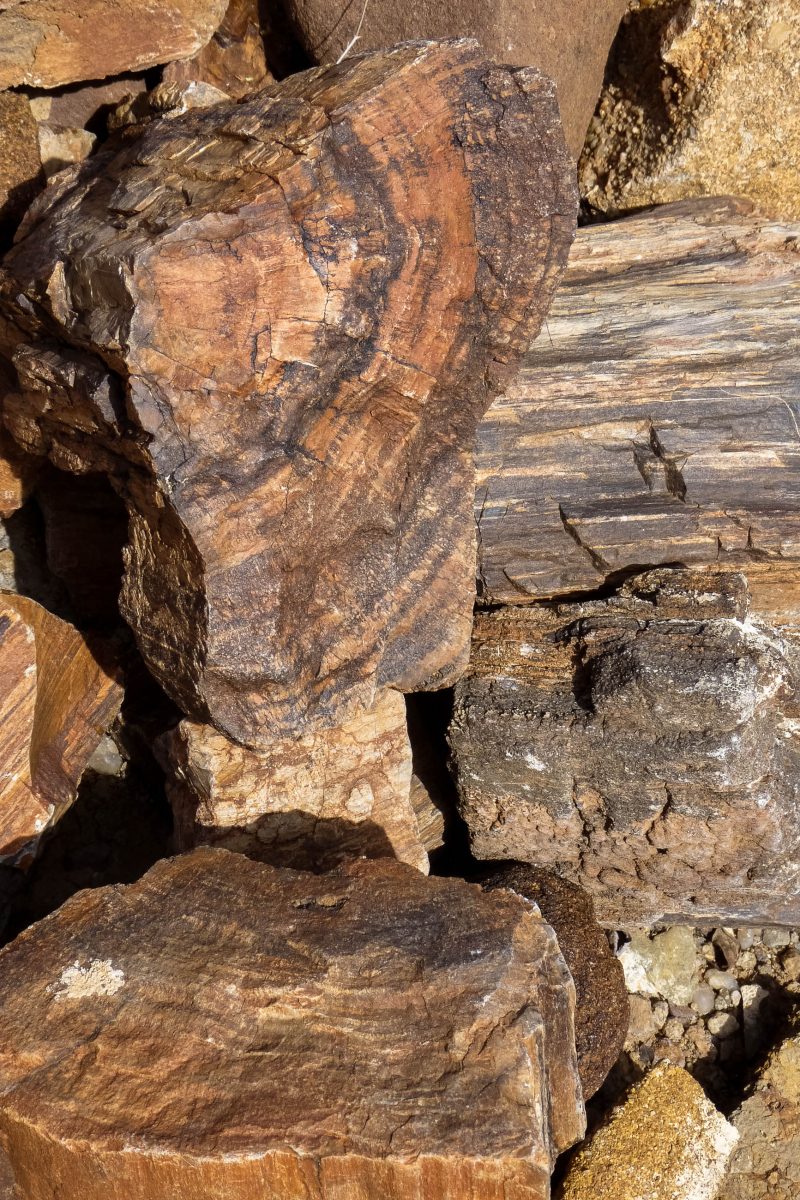
Das offizielle Areal des versteinerten Waldes umfasst ca. eine Fläche von 300×800 Metern. Hier liegen 50-60 Stämme am Boden, von denen die größten Fossilien über 30 Meter lang und bis zu einem Meter dick sind. Die Bäume waren zu Lebzeiten aber vermutlich noch um einiges größer. Dieses Naturphänomen ist so einzigartig, dass es zum nationalen Denkmal in Namibia erklärt wurde.
Der versteinerte Wald in Namibia lädt wie kaum ein anderer Ort zu einer Reise in längst vergangene Zeiten ein. Die Bäume sind unglaublich gut erhalten. Sie wurden durch glückliche Umstände luftdicht abgeschlossen und über Jahrmillionen hinweg durch Kieselsäure versteinert.
Trotz ihres atemberaubenden Alters sind sogar die einzelnen Jahresringe der Bäume deutlich erkennbar, ganz so als seien sie gerade erst umgefallen. Deswegen möchte man auf den ersten Blick gar nicht glauben, dass der versteinerte Wald so viele Jahrmillionen auf dem Buckel hat.
Der „private“ versteinerte Wald
Neben dem offiziellen Areal gibt es in der näheren Umgebung auch einige „private“ Anbieter. Auf diesen Gebieten warten Einheimische auf Touristen. Gegen eine geringe Gebühr führen sie die Besucher zu den am Boden liegenden steinernen Riesen.
Die Anzahl der versteinerten Bäume ist an diesen privaten Plätzen relativ überschaubar, dafür hat man die Fossilien aber meist für sich alleine.
Neben diesem faszinierenden Zeugnis der Urzeit findet der Naturfreund zwischen den Stämmen auch noch viele Exemplare einer besonders kuriosen Pflanze: Die riesige Welwitschie wächst nur in der Wüste Namib und im Süden Angolas und gilt als lebendes Fossil. Die riesigen Pflanzen sehen mit ihren dicken, meterlangen Blättern und zapfenartigen Blütenständen nicht nur sehr skurril aus, sie werden auch bis zu 2000 Jahre alt.
Welwitischia mirabilis
Die Welwitschie, benannt nach ihrem Entdecker, dem österreichischen Arzt und Botaniker Friedrich Welwitsch, kommt nur im Westen Namibias und im Süden Angolas vor und hat sich mit ihren dicken, fleischigen Blättern perfekt an das Wüstenleben angepasst. Sie besteht nur aus zwei Laubblättern, die sich manchmal auffalten, wodurch sie den Anschein mehrerer Blätter erweckt. Die Welwitschie wird nur 0,5m hoch, doch ihre Blätter können knapp 3m lang werden. Die größte Welwitschie hatte gar einen Umfang von 8,5m. Die „welwitschia mirabilis“ („wunderbare Welwitschie“) ist im Wappen von Namibia, Kunene und Swakopmund abgebildet. Der Londoner Botaniker William Jackson Hooker bezeichnete die Pflanze einst als „wunderbarste, die jemals in dieses Land (England) gebracht wurde, und eine der hässlichsten“.





